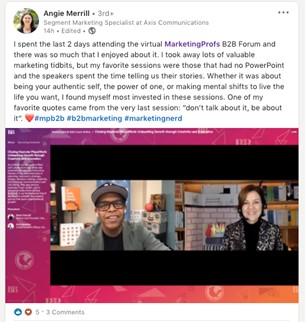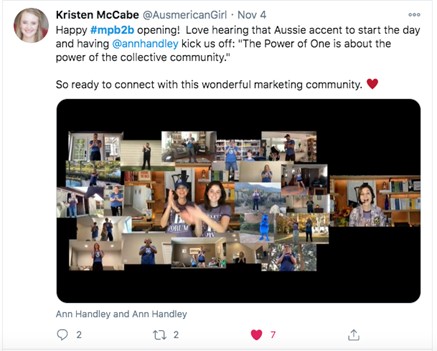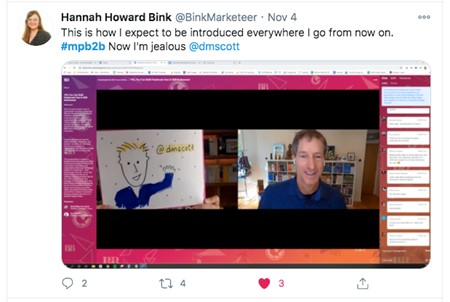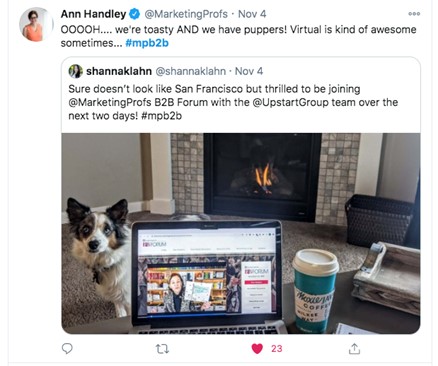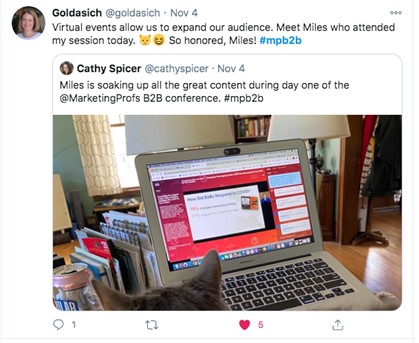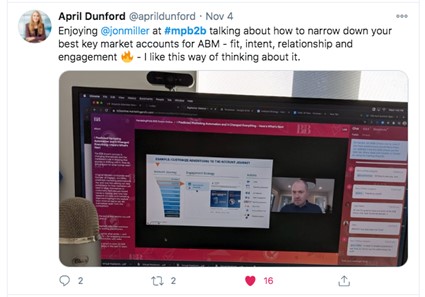The headline of this article was the question we at MarketingProfs started asking ourselves earlier this year as we realized that our annual event, scheduled for San Francisco, wasn't going to happen.
You would think that a company that has been hosting virtual, live marketing education for years would have no qualms about turning its flagship in-person B2B Forum into an online event. You'd be wrong.
We knew the online event couldn't and shouldn't be the same experience, but we wrestled internally about what it should be instead.
Our core mission was to try to create the same energized, connected feeling our attendees get from the in-person conference.
Here are four things we learned during planning and execution.
1. Live virtual event sessions don't mean better
Are you fighting with your company about live sessions vs. pre-recorded? According to our attendees, a lot of us are.
In an effort to mitigate technical issues and have some quality control over the sessions, we decided to have all of the presenters (except for our final keynote with Kevin Carroll) pre-recorded.
However, we were worried about the "canned" feeling of the sessions. To counter that, we...
- Were transparent and told attendees the sessions were pre-recorded
- Had a moderator and the speaker say a live "hi" at the start of the session
- Had the speakers watching their session with the attendees to live-chat, answer questions, and joke with the participants in real-time (we called it a watch party)
- Encouraged attendees to post questions for a live Q&A at the end (other attendees could vote on which questions they wanted answered)
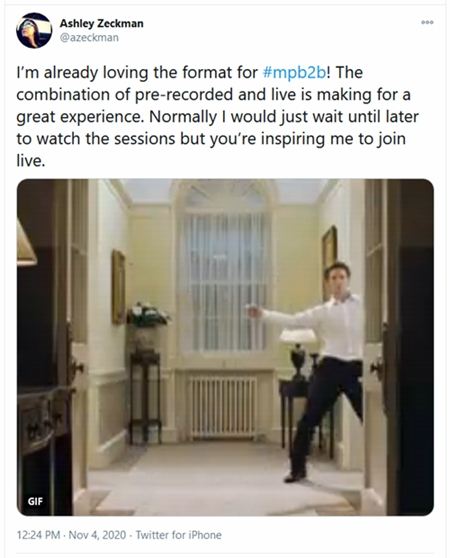
Takeaway: Virtual became a completely different but not "less than" experience. Attendees actively participated during the sessions instead of just watching. Pre-recording also helped us keep to our schedule!
2. Still expect the unexpected—but realize it's just different
Anyone who's ever planned a live event knows that there are always issues with the hotel, rooms, food, session flow—heck, even with the weather. There is no perfect event, even if it seems that way to your attendees. Virtual events are no different.
- Leave plenty of time for technology selection. Just as with selecting a hotel, it can take a long time and lots of "site visits" to pick a technology to host your event. Because this tech space has exploded, many vendors are backed up. It may take time to even get a demo. And, though this type of technology has existed for years, the popularity of it means new companies are entering the space every day, which means lots of choices to sort through.
- Check all of your channels because questions pop up in the most unexpected places. Despite having a "get help" button in the virtual lobby and an info desk that was manned throughout the event, we hopped over to check our PRO Facebook group and saw questions coming in on that channel as well. We quickly started posting important announcements in that group, on Twitter with our #mpb2b tag, and in the event platform itself.

- Have separate "mission control" real-time communication for the entire team. Since we were all sitting in our homes, we couldn't run to our event lead with problems we were coming across. Using a real-time chat channel, separate from the environment (we used Slack) helped everyone stay connected, quickly report issues, and laugh throughout the day.
Takeaway: Just like with in-person events, anything can happen—just different things. Speakers are late, there are tech issues, a participant's corporate IT blocks the platform provider you selected, and on and on. Have a guide for the event staff team, a schedule, platform training, and a real-time mission control.
3. Rethink everything
Everyone jokes about death by Zoom, but we've all got digital fatigue. We've also have to think about how to keep participants enjoying the experience while they're also home schooling their kids, checking work emails, and worrying about the state of the world.
- Encourage participants to turn on their out-of-office message. This tip came from our networking lounge chat, and we thought it was a great one. Learning is learning, no matter the delivery method.
- Keep your sessions short and memorable. We were really worried about this one. Can you really learn from a 20-ish-minute presentation and a 10-minute Q&A? It turns out you can. What we found is the shorter format (along with speaker creativity) allowed speakers to pack a punch in condensed time.
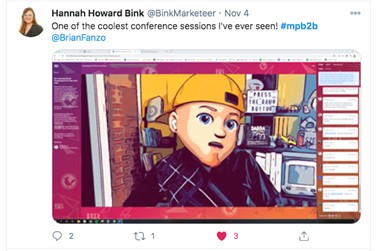

- Keynotes are no longer just for kickoff. We had four keynotes: one at the start of each day, one at lunch, and one to end the conference on Day 2. Those helped bring people back if they had started to drift away.

Takeaway: Trying to make a virtual event a replica of a live event doesn't work. Some elements can be the same, but many need to be reimagined. In virtual, it's about your content and THE WAY it is delivered.
4. Give participants the human connections they're craving
One of the things people love about their favorite live events is how they feel during and after a conference. It's a rush of ideas, fun, and feeling connected. One of the biggest challenges every marketer faces is how to translate that into an online event. How do you create that experience when you can't have cocktail parties, wow moments, and those random meetups over breakfast?
Storytelling and emotion are even more important
